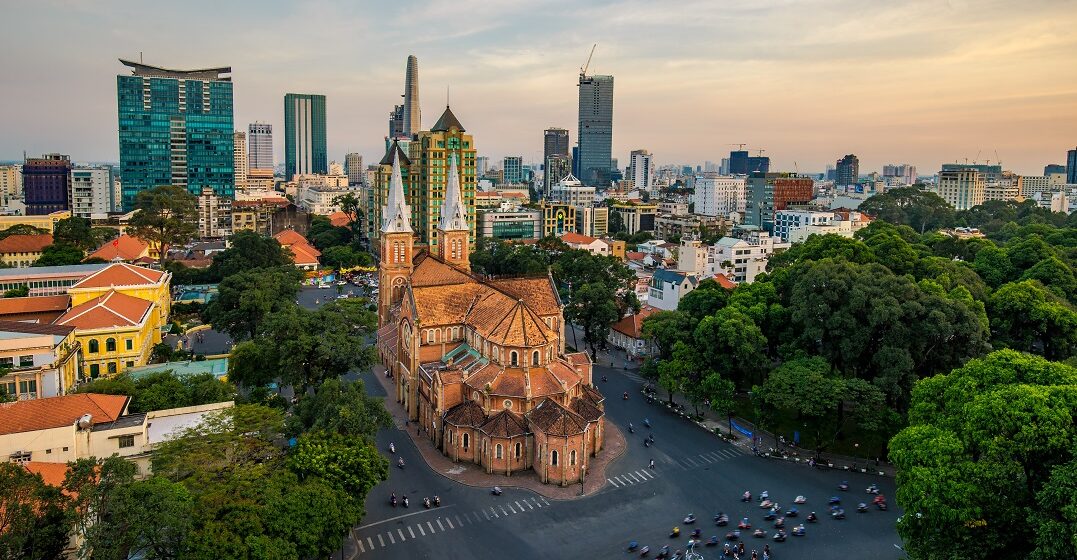Published on September 7, 2023

Why do people speak French in Vietnam?

Did you know that French is the fifth most spoken language in the world? Throughout its history, the French language has spread well beyond the borders of France. This is why today, from Québec to Polynesia, 300 million people speak French across the globe. If you needed another reason to start learning French, these numbers might do the trick. And the French language can truly be heard in every corner of the world — including Southeast Asia.
Take Vietnam, for example. France has maintained strong links and a shared (albeit complicated) heritage with its former Asian colony. To this day, if you travel and speak with locals in Vietnam, you might find that many of them do speak French. But French is far from the only foreign language in the country, and French has lost considerable ground to English in the last few decades. Let’s explore the linguistic roadmap of Vietnam and where the French language has fit into it over the years.
Vietnamese is the sole official language of Vietnam. It is the native language of about 85% of the population, including about two million immigrants. Officially adopted in 1945 in lieu of the Chinese system of writing, the Vietnamese alphabet is called Chữ Quốc Ngữ and is based on the Latin script.
Spoken Vietnamese can be grouped into three dialects defined by their prominence in different regions of the country: North Vietnamese (which you’ll hear in the capital of Hanoi as well as in other Northern cities), Central Vietnamese and South Vietnamese. Grammar and vocabulary are generally shared among the three dialects, and only the pronunciation differs significantly. North Vietnamese is considered the official pronunciation.
Due to history and various influences, you may also hear several other foreign languages when traveling in the country. As France colonized Vietnam for a period of about 60 years, French remains one of the most common foreign languages in Vietnam. Russian, Czech, Polish and German are also spoken by small parts of the Vietnamese population. However, English has emerged as the top foreign language spoken and learned in Vietnam. The spread of English has only accelerated in the decades since the Vietnam War, and English is now a very useful tool for both business and tourism.
The reason is simply historical. Vietnam remained under French colonial rule from 1887 to 1940. Over the entirety of this period, French was the official administrative language and was required to pass education exams and to move up the social ladder.
At the end of World War II in 1945, Vietnam declared its independence from France and Vietnamese became the country’s official language. However, France tried to regain control by setting up the fédération d’États associés de l’Union française (Federation of states associated with the French Union). Negotiations failed, and the guerre d’Indochine (Indochina War) began in late 1946. French continued to be used in education and in urban areas still under French control during the war.
Following the French defeat at Diên Biên Phu in May 1954, the Accords de Genève (Geneva Accords) were officially signed in July of that year. This agreement not only divided the country between North Vietnam and South Vietnam but also made Vietnamese the official language and writing system.
The division of the country eventually created a linguistic divide. In the North, a strict language policy established Vietnamese as the exclusive language of instruction. In the South, due to the continuation of a strong French education system for the elite and the presence of French-educated people in government, the French language didn’t lose all its power — at least not right away.
In the following decades, the influence of the French language slowly diminished in favor of English, which was taught in schools as early as 1957. Nearly 30 years later, in 1986, the economic reforms of đổi mới (“renovation” or “innovation” in Vietnamese) allowed many English-speaking foreigners to come to Vietnam. English quickly emerged as the primary foreign language. Across a ten-year span from 1996 to 2006, it spread at a dizzying pace, with about 90% of foreign-language learners in Vietnam choosing to study English.
By contrast, only a small number speak French in Vietnam today, and they tend to belong to the older generation. According to 2022 figures from the Organisation Internationale de la Francophonie (International Organisation of the French-Speaking World), there are currently 693,000 French speakers in Vietnam, representing only 1% of the total population.
In spite of this small figure, Vietnam remains an active player within the French-speaking world. It has been a member of the Organisation Internationale de la Francophonie (OAF) since 1970, and the French embassy in Hanoi has set up several programs to promote the French language in the country. French media also contributed to the effort. The newspaper Le Courriel du Vietnam (Vietnam Mail) offers articles in French and French television programmes are broadcast on VTV, the main TV channel in Vietnam.
The influence of the French language in Vietnam also extends to the Vietnamese language itself. Many Vietnamese words are direct loanwords from French, as the table below shows:
| Vietnamese | French | English |
| ăng lê | anglais | English |
| cà phê | café | coffee |
| ga tô | gateau | cake |
Perhaps you met some locals while traveling in Vietnam and you were puzzled about why they spoke French. Well, now you have the answer! From colonial times to today, French has played an important part in the modern history of the country and continues to be actively promoted. Even if it has lost its dominance, it’s part of the shared heritage between the two distant countries and has even contributed to the vocabulary in Vietnamese.